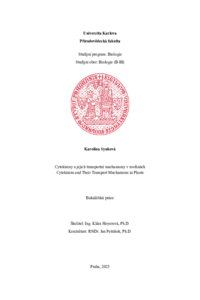Cytokininy a jejich transportní mechanismy v rostlinách
Cytokinins and Their Transport Mechanisms in Plants
bachelor thesis (DEFENDED)

View/
Permanent link
http://hdl.handle.net/20.500.11956/199523Identifiers
Study Information System: 272247
Collections
- Kvalifikační práce [20861]
Author
Advisor
Consultant
Petrášek, Jan
Referee
Plíhal, Ondřej
Faculty / Institute
Faculty of Science
Discipline
Biology
Department
Department of Experimental Plant Biology
Date of defense
2. 6. 2025
Publisher
Univerzita Karlova, Přírodovědecká fakultaLanguage
Czech
Grade
Excellent
Keywords (Czech)
rostlinné hormony, cytokinin, trans-zeatin, transport cytokininů, membránové přenašeče, ENT proteinyKeywords (English)
plant hormones, cytokinin, trans-zeatin, cytokinin transport, membrane bound carriers, ENT proteinsCytokininy jsou fytohormony, jejichž objevování začalo již na začátku dvacátého století. Mají velké množství fyziologických funkcí, jako je iniciace buněčného dělení, oddálení senescence, urychlení vývoje chloroplastů a další. Jedná se o deriváty adeninu substituované v N6 pozici a nejvíce fyziologicky aktivním cytokininem je trans-zeatin. Cytokininy se mohou v rostlině vyskytovat ve formě glykosidů, ribotidů, ribosidů a volných bází, které jsou jedinou aktivní formou rozpoznávanou receptory u Arabidopsis. Aby docházelo ke správné signalizaci a následným účinkům, musí být cytokininy v rámci rostliny transportovány. Transport probíhá mezi orgány, kdy je zajišťován především vodivými pletivy, a také mezi buňkami přes plazmatické membrány. Transport přes membrány zajišťuje velké množství transportérů z rodin proteinů ABCG, PUP, AZG, SWEET a ENT. Cytokininy nejsou syntetizovány pouze rostlinami, ale například také některými bakteriemi, které žijí v rhizosféře. Je to například Azotobacter chroococcum, Paenibacillus polyxyma nebo Agrobacterium tumefaciens. Velmi zajímavým zjištěním je, že tyto cytokininy produkované bakteriemi mohou být rostlinou přijímány a mít pozitivní vliv na její růst.
Cytokinins are phytohormones whose discovery began in the early twentieth century. They have a large number of physiological functions, such as initiating cell division, delaying senescence, accelerating chloroplast development, and others. They are derivatives of adenine substituted at the N6 position and the most physiologically active cytokinin is trans-zeatin. Cytokinins can occur in the plant in the form of glycosides, ribotides, ribosides and free bases, which are the only active form recognized by receptors of Arabidopsis. Cytokinins must be transported within the plant for proper signalling and subsequent effects to occur. Transport takes place between organs, mainly facilitated by vascular tissue, and also between cells through plasma membranes. Transport across membranes is provided by a large number of transporters from the protein families ABCG, PUP, AZG, SWEET and ENT. Cytokinins are not only synthesized by plants but also by certain bacteria that live in the rhizosphere. This is for example Azotobacter chroococcum, Paenibacillus polyxyma or Agrobacterium tumefaciens. A very interesting finding is that these cytokinins produced by bacteria can be taken up by the plant and have a positive effect on its growth.
